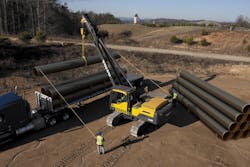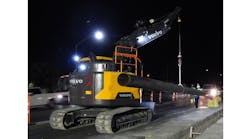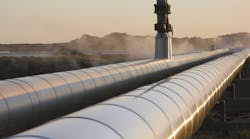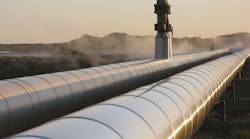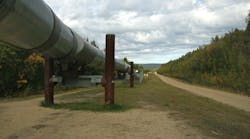Pipelaying contractors must choose between crawler dozer bodies with sidebooms or excavator-style pipelayers, where the excavator arm is essentially replaced with a boom and the upper structure can rotate during placement.
The OEMs making dedicated pipelayers in the U.S. today are Caterpillar (dozer/sideboom) and Volvo (excavator style), but there’s a third option to be aware of: retrofitting crawlers with booms made by a third party. Surprisingly, one such retrofitter even has the capability to fit backhoe-loaders and wheel loaders with certain sizes of booms.
And don’t forget used machines—an opportunity to cut acquisition cost and perhaps take advantage of a larger supply of pipelayers available during the current downturn in the oil industry.
Crawler sideboom
Cat released three pipelayers in 2014, billing them as completely purpose-built units. The PL72, PL83, and PL87 pipelayers have an integrated all-Cat power train with differential steering and an electronically controlled hydraulic system that places all lifting functions into one joystick.
Rated lift capacities are 90,000 pounds, 170,000 pounds and 216,000 pounds, respectively. The models have Cat’s hallmark non-suspended elevated-sprocket undercarriage, and mainframes and main cases built to resist operating stress unique to pipelayers. The enclosed cab option was designed by Caterpillar specifically for pipeline applications, allowing truck transport with the ROPS in place.
Advantages of dozer/sideboom units are flotation, the ability to operate on slopes, and speed.
But the choice between sidebooms or excavator-style units often comes down to the specific application and lifting capacity required, speed, terrain, and how much maneuverability may or may not be needed on the job site.
Excavator-style pipelayers
Volvo Construction Equipment offers three models, the PL3005D, PL4611, and PL4809D, with tipping capacities from 50 to 110 tons.
Their main advantage over crawler sidebooms is a 360-degree swing design, just like an excavator, for repositioning pipes without having to move the machine. The units also have a hydraulically elevating cab similar to those seen in material handlers, and the booms can be replaced with optional excavator arms for digging in as little as 2 hours 31 minutes (PL3005D), the company says.
Ed Kosarek, VP of field operations with Patterson & Wilder Construction, used the excavator-style Volvo PL4608 rotating pipelayer as a subcontractor on the Elizabeth River Tunnels Project connecting Norfolk and Portsmouth, Va. The work included installing a 36-inch water main under the river itself.
“This is a fairly large project in terms of length and diameter,” Kosarek says. Because of the pulling forces exerted on the machines, he explains that the company wanted to ensure the machine’s capacity exceeded the requirement by at least 50 percent to execute the project successfully and safely. He also wanted versatility.
“The major difference between this pipelayer and one of its major competitors is the fact that it is actually a rotating pipelayer,” Kosarek says. “The tracks can stay stationary, but the whole cab and boom of the machine can rotate. There’s no other pipelayer that can do that, and that’s really what turned us toward the Volvo in this situation. It’s just a much more versatile machine for this application.”
Retrofitting
Depending on budget and project timing, retrofitting an existing crawler with a sideboom might be more desirable than a new unit. New, dedicated pipelayers run in excess of $750,000.
Midwestern Manufacturing, Tulsa, Okla., produces 18 different sidebooms for crawler dozers with lift capacities from 10,000 to 230,000 pounds. It also has three versions for backhoes and wheel loaders, with 10,000- to 33,000-pound capacities.
The sidebooms, and counterweights and hydraulic conversion kits, are available for new or older-model equipment. Midwestern has also partnered with dozer makers that do not manufacture dedicated pipelayers, including John Deere and Komatsu.
Midwestern’s founder, Armon H. Bost, developed the first hydraulic-operated sideboom in 1953.
The used option, keys for inspection
Another route to lowering acquisition costs is a used unit. There are likely more machines to choose from right now due to economic conditions in the oil industry. Ritchie Bros., the world’s largest industrial auctioneer, points out some key differences in buying used versus new:
A pipelayer is a specialized piece of equipment. “In general, used heavy equipment holds its value because it can do the same job as a new piece of equipment, but for a lot less money,” says Doug Olive, Ritchie Bros. Senior VP, Pricing. “The same holds even truer for such a specialized piece of heavy equipment like a pipelayer. Yes, other heavy equipment could serve as stand-ins to do a pipelayer’s job, but these replacement machines would lack the precision and efficiency of a pipelayer designed specifically for lifting, bending, lowering and, overall, handling pipe.”
A pipelayer requires [ASME B30.14] certification before it’s work-ready. Before putting a pipelayer to work on a project, owners are required to have their machine inspected and certified to ensure it is in compliance with regional authorities.
“This process usually involves regular maintenance and an annual boom inspection,” Olive says. “When buying a used pipelayer, there is a good chance the machine has been well maintained and is already certified, which saves the buyer time and money.”
Most pipelayers will have many operating hours left when they are liquidated at the end of a project.
Lower on-the-job utilization. Because of its specific role on a project, a pipelayer is considered a piece of support equipment and is utilized during a defined phase of the project lifecycle, not for the entire duration of the project as dozers and other mainline equipment. “Lower utilization means a pipelayer will have many operating hours left when it’s liquidated at the end of a project to recoup expenses,” Olive says. “Depending on the length of a project, the price paid for the pipelayer and the project costs, buying a used pipelayer with few operating hours can help owners get their money out of the machine well before the machine is worn out.”
Finally, there’s global demand to keep in mind at asset disposal time.
“Despite current conditions, oil and gas pipeline projects are planned or underway in almost every corner of the world,” says Olive. “Couple the increased demand for fuel delivery infrastructure with the fact that pipelayers can work all over the world because of uniform legislation and job specifications, and it’s easy to understand why global demand for these machines continues to exist.”
When purchasing a used pipelayer, the company offers further tips on what to inspect before buying:
“Carry out the undercarriage inspection just as you would for a crawler tractor,” Olive says. “View detailed photos of undercarriage parts and inspection tips for crawler tractors. During your undercarriage inspection, take your time to note the percentage of undercarriage remaining. Include percentages remaining for each individual component as well, including rails, rollers, idlers, sprocket segments and track pads.”
When inspecting a pipelayer, inspect both tracks and all track components. Make sure all track pads and bolts are tight and note any missing pads or bolts. Look for signs of wear on drive sprocket teeth and check chain bushings for wear. Also, check the final drive for any leaks. Once you’ve checked the undercarriage on one side of the machine, continue your inspection on the opposite side. Remember to check the track frame, sway bars and stabilizers for any scarring caused from contact with hard surfaces.
Next, consider the engine, hydraulics and radiator.
When inspecting a sideboom, check for any damaged hoses, chafed wires or wet spots.
“Make your way to the front of the pipelayer and climb up to take a look inside the engine compartment,” Olive says. “Look for any damaged hoses, chafed wires or wet spots. A wet spot inside the engine compartment may be a sign of a hydraulic leak. While inspecting the engine compartment, check the tightness of the fan guard and fan belts. Also check the fan belts for any cracks. Inspect the radiator for any dirt build-up, damage or fluid leaks.”
Also inspect the boom, sheaves, wire ropes, hooks and counterweights.
Check the wire rope on boom and hoist lines for signs of corrosion, thinning, breakage, fraying or kinks.
“Walk your way around the boom, looking closely for any cracks, bends, welds or dents that may signify damage,” he says. “Make note of any cracks in the paint around main pivot points, which could be a sign of metal fatigue. Check the boom for a current certification decal and note the date of the last inspection. As you approach the end of the boom, check the hook for any cracks and for a smooth swiveling motion. Make your way back to the sheave, again checking for any cracks and for the overall condition of bearings. Move to the opposite side of the pipelayer, and check the counterweights for any modifications.”
After inspecting the boom, complete another walk around the entire pipelayer, this time inspecting the condition of the sheet metal on the body. “As you move around the machine, check the main supports of the ROPS for any bends or other damage that could affect its ability to protect an operator in the event of a rollover,” Olive says. “Many regional safety authorities require that a pipelayer be fitted with a ROPS. Check with your local safety authority to find out if any pipelayer you buy will require a ROPS. Most pipelayers can be retrofitted with a certified ROPS starting at $20,000.”
Lastly, cover general operation and lift capacity.
Climb into the operator’s station. Ensure all lights, the back-up alarm and any other safety features are functioning. Operate the boom, hoist and counterweight controls, taking note of any operational problems or abnormal sounds. If included, check the function of the load-management system.
“Once you’ve completed your visual and functional inspection, ask to view the pipelayer’s service record or work orders,” Olive says. “Unless you are very experienced and know what to look for when inspecting a pipelayer, have a qualified mechanic or knowledgeable operator carry out the inspection.”
